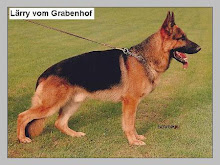In today's article about the first week of training your dog, we are going to apply a basic method that was originated by Mr. William Koehler, a respected animal trainer. His first week's long-line method (slightly changed here) should be highly praised as one of the greatest innovations in canine training.
Regardless of how basic and unpromising these first-week steps may seem, follow them carefully and exactly, and you will have a more obedient dog, one that will learn easier and faster.
Let The Training Begin
On your first day of training, take your dog to the backyard, the sidewalk, or the park (only if it provides little to no distractions). Put the training collar on your dog, making sure that it’s fitted correctly. Tie one end of the long-line to the free ring. Holding the other end of the long-line in your hands, pick a spot at a distance of about thirty to forty-five feet. It could be a tin can, a fire hydrant, or a particular patch of grass. Walk fast in a straight line to that spot. Determine to let nothing stand in your way, especially your dog and his tricks.
If yours is the type of dog who has had no form of total control placed over him, you can bet there’ll be tricks. He may start wailing, which means that he would prefer to go in some other direction and you are not cooperating.
He might roll over on his back and place all four feet in the air trying to hook a claw in the sky, which means he doesn’t particularly want to walk with you because you’re not going to the direction he wants. He may even try to rest directly in front of you which simply means that you forgot to ask his permission to walk, and he’d prefer that you stand still until he’s make up his mind.
In training your dog, you need to keep one thing perfectly clear in mind so that it will also be clear in the mind of your dog: You are training your dog, not the other way around.
Regardless of his tricks, and with the end of the long-line held firmly in your hand, go to the destination that you’ve chosen. As Mr. Koehler expresses “Your dog will go with you if for no other reason than to be near you”.
That first sixty seconds of training (the time it takes you to walk thirty to forty-five feet) may indeed be a test of wills. It is crucial that your dog develop assurance that you will win this test of wills. He will develop this assurance if he knows that you will go from point A to point B without considering his resistance.
By the time you reach your predetermined location, the learning processes will have already been triggered within the mind of your dog, so simply stand there for about forty-five seconds to a minute. Look around and observe everything around you except your pet. Do not even look at him. Doing so just might possibly get you hopelessly entangled in an emotional struggle.
When your forty-five seconds to one minute is up, pick another spot at about the same distance and, without warning or tugging on the leash to get your dog’s attention, walk at a brisk pace right to it. Again, do not let your dog stand in your way. If you have to clear your throat or in some other way try to catch your dog’s attention before moving, then your dog is doing a great job of training you.
Don’t ask your dog’s permission to walk and just go! When you reached your spot, pause again for about forty-five seconds to observe your surroundings – but not your dog. Again, pick a location and, without any warning, walk to it at a brisk pace. Continue this process for the full fifteen-minute training session.
Subscribe to:
Post Comments (Atom)


No comments:
Post a Comment